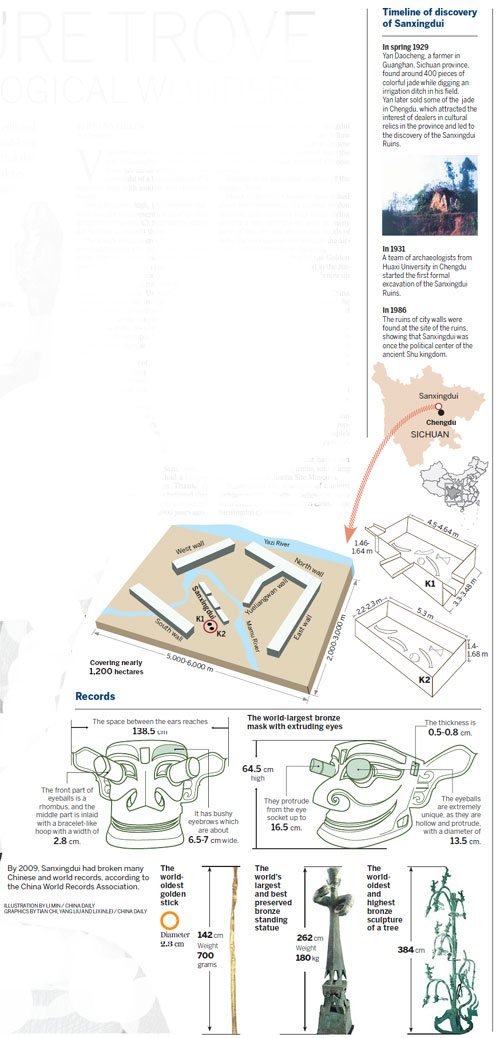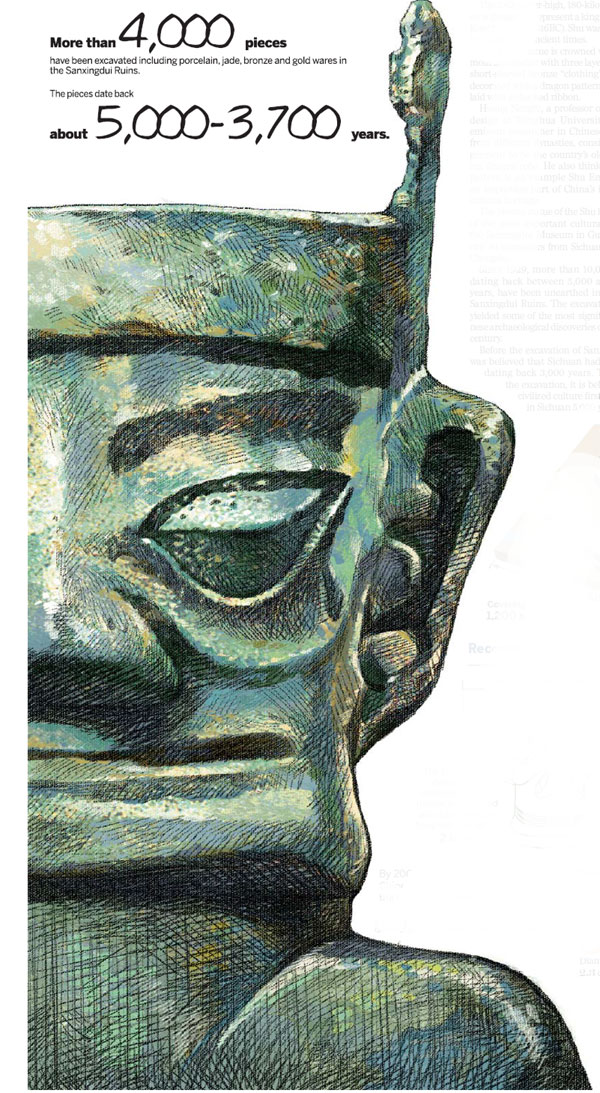Treasure trove of archaeological wonders
Sanxingdui is the area where the province's oldest ancient cultural relics have been discovered and was pinpointed as a national-level key cultural relics area in 1988. Archaeologists discovered that the relics there could be divided into four phases. The earliest dates back to the late phase of the Neolithic Period 5,000 years ago.
Visitors to the Sanxingdui Museum in Guanghan, Sichuan province, are faced with the impressive sight of a bronze statue of a barefoot man with anklets and clenched hands.
The 2.62-meter-high, 180-kilogram statue is thought to represent a king of the Shu Kingdom (1045-316BC). Shu was the name for Sichuan in ancient times.
The king's statue is crowned with a sun motif and coated with three layers of tight, short-sleeved bronze "clothing", which is decorated with a dragon pattern and overlaid with a checked ribbon.
Huang Nengfu, a professor of arts and design at Tsinghua University and an eminent researcher in Chinese clothing from different dynasties, considered the garment to be the country's oldest existing dragon robe. He also thinks that the pattern is an example Shu Embroidery, an important part of China's intangible cultural heritage.
The bronze statue of the Shu king is one of the most important cultural relics in the Sanxingdui Museum in Guanghan, a city 40 kilometers from Sichuan's capital, Chengdu.
Since 1929, more than 10,000 relics, dating back between 5,000 and 3,000 years, have been unearthed in the city's Sanxingdui Ruins. The excavations have yielded some of the most significant Chinese archaeological discoveries of the 20th century.
Before the excavation of Sanxingdui, it was believed that Sichuan had a history dating back 3,000 years. Thanks to the excavation, it is believed that civilized culture first appeared in Sichuan 5,000 years ago.
Archaeologists say that the Sanxingdui Ruins also dispel theories that the Yellow River was the sole starting point of Chinese civilization. It is now believed that the Yangtze River is also a source of Chinese civilization.
Sichuan is in the upper reaches of the Yangtze River.
Many visitors to Chengdu have asked about the significance of a circular golden emblem that features four birds flying around a sun, and can be seen in many parts of the city and also on the hoods of taxis, the overpass on the route to the airport, and local television channels.
The emblem is a replica of the Golden Sun Bird, which was unearthed in the Jinsha Ruins in the city in 2001 and is now on display in the Jinsha Site Museum.
The Archaeological Society of China and China Cultural Relics News rated the excavation of the Jinsha Ruins as one of the top 10 archaeological finds of 2001.
The most eye-catching relic at Jinsha Museum is the Golden Sun Bird, which is believed to be about 3,000 years old. Made from delicate gold foil, it depicts four birds and 12 sun rays radiating from its center.
In 2005, the State Administration of Cultural Heritage adopted the Golden Sun Bird as the symbol of China's cultural history.
The administration based its selection on the item's exquisite craftsmanship, representation of the ancient Chinese people's worship of the sun and the country's enterprising spirit.
Some 10,000 cultural relics have been unearthed in the Jinsha Ruins, said Wang Yi, curator of the Jinsha Site Museum.
Showcasing the splendor of ancient Sichuan culture, Jinsha is believed to have been created by ancients who created the Sanxingdui civilization.



(China Daily 07/23/2016 page37)














